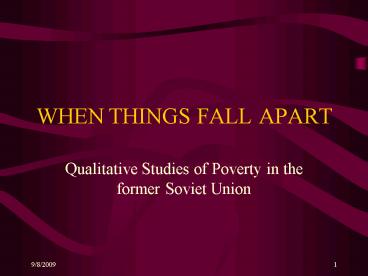WHEN THINGS FALL APART PowerPoint PPT Presentation
1 / 16
Title: WHEN THINGS FALL APART
1
WHEN THINGS FALL APART
- Qualitative Studies of Poverty in the former
Soviet Union
2
things fall apart
- Title draws both on Yeats The Second Coming
(1921) Things fall apart the center cannot
hold written between the two World Wars, - and Chinua Achebes great 1958 novel about the
Ibos painful transition to a post-colonial world
3
Background of the studies
- Qualitative studies of poverty in 8 FSU countries
- Studies conducted 1993-1998 some along with LSMS
or quant surveys some for projects - Most authors anthropologists had lived in the
FSU spoke local languages
4
Key messages
- Methodological the importance of qualitative
approaches for understanding the relationship
between perceptions, experiences and behavior - Multidimensionality of poverty
- Unique aspects of poverty in the former Soviet
Union (FSU) - Importance of country knowledge
5
Contents of the study
- A Window on Social Reality Qualitative methods
in poverty research - From Soviet Expectations to Post-Soviet
Realities Poverty during the transition - Central Asia Kyrgyz Republic, Tajikistan,
Uzbekistan - South Caucasus Armenia, Georgia
- West of the Urals Ukraine, Moldova, Latvia
6
Methodology
- Purposive sampling of sites households
- 100s of open-ended HH, key informant interviews
FGs, observation of living conditions - Generalizability based on large samples
- Authors prepared instruments, recruited and
trained teams, worked with them in the field - Analysis based on individual interview
reports/summaries or transcripts
7
The importance of qualitative approaches for the
FSU
- Former Soviet countries undergoing abrupt change
little studied poorly understood - Standard LSMS categories (household employment)
not always applicable - More suitable for exploring sensitive issues
(corruption, deviance, quasi-legal survival
strategies)
8
Whats different about post-Soviet poverty?
- Volume covers 8 countries with distinct
pre-Soviet histories and cultures - Carried out in different years, studies document
emergence, evolution and institutionalization of
poverty in FSU - Demonstrate differentiation and diverging
approaches to poverty among new nation-states
9
A chronology of Soviet poverty
- Steady improvement in standard of living
1960-1980 serious poverty hidden (prisons,
residential institutions) - Inflation, shortages, rationing in the 1980s led
to growth of shadow economy, strengthened
reliance on informal networks - State dissolution and economic collapse spared
no-one except top political and economic elite
10
The collapse
- State fragmentation sundered trade links caused
abrupt drop in production, employment - Shortages of fuel, electricity brought economic
and daily life to a standstill, esp. in cities - Social services crippled
- Hyperinflation people lost life savings
overnight - Burgeoning criminality, explosion of mafias
- Leadership without credibility
11
The new poor
- New poor from all walks of life most were
educated, previously employed socially
integrated into their communities - Shared ideological conviction/assumption that
state should provide employment, services, and
prevent large socioeconomic disparities - Historic denial of and strong public disapproval
of poverty created sense of humiliation
12
Response to shock
- Work tied to social status unemployment linked
to shame, depression, alcoholism, suicide - Inability to participate in ceremonial/ritual
obligations led to exclusion from networks - Gendered response women more resilient men
emasculated/paralyzed
13
Initial coping strategies
- People used networks established in Soviet period
- Reduced consumption pilfered state assets sold
own assets/housing, went into debt - Subsistence gardening became safety net
- New micro-enterprises vulnerable to mafias
- Expanding shuttle trade (women) labor migration
(men) - Emigration to other FSU countries Europe, N.
America
14
The normalization of poverty
- Street children, bag ladies, refugees, and
Mercedes co-exist visible rich-poor gap - Sharp socio-economic stratification, social
networks of rich and poor separate, linked by
clientelism - Institutionalized Soviet-era corruption has
expanded, diversified, become more violent - Pervasive insecurity vulnerability to shock
- Collapse of old institutions new ones still
fragile
15
Conclusions
- Similar psychological response and coping
strategies across FSU, along with increasing
diversity in patterns of growth, opportunity - Weak Soviet institutions provided poor basis for
institutions of newly independent states, (need
more attention to governance issues) - Deep nostalgia among middle/older generations
continued expectations of state as provider
belief in social justice, egalitarianism
16
What next?
- Poverty studies should include non-poor
- More nuanced examination of social relationships
(social capital) - Devote more serious attention to building
capacity of local researchers provide better
tools for policymakers - Policies should target pockets of extreme
poverty, where exclusion is eroding prospects of
children/youth

